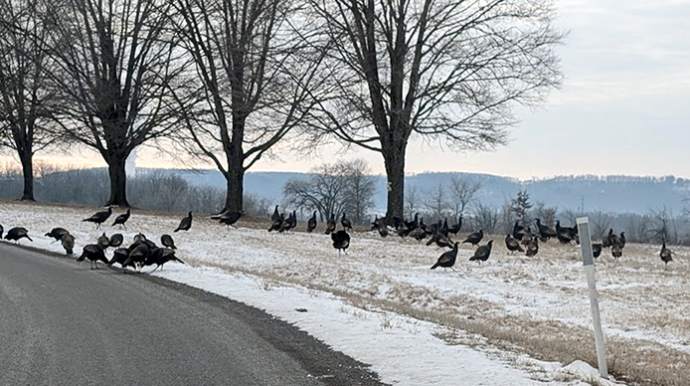I know turkey season is over, but like many hunters, I’m always on the lookout for game — especially turkeys.
Spotting flocks of turkeys now, may lead to some potential hunting sites — especially when spring gobbler season rolls around.
I’ve been seeing turkeys here and there all fall and into the winter months, but most sightings were of small groups of a half-dozen or so, but that changed last week.
On our way to the Bloomsburg Fair Grounds to participate in the Early Bird Show, my wife and I had to come to a complete stop at one location since about fifty turkeys were starting to come out onto the road. Some of the turkeys were gobblers, and some even fanned out while we sat there waiting for them to move out of the way. I’ve included a photo of the event with this writing.
In the meantime, the Pennsylvania Game Commission is asking for the public’s help if you spot flocks of turkeys. The Game Commission is looking for turkeys to trap for ongoing and new turkey projects and research. The agency is asking people to report the location of any turkey flocks spotted between now and March 15. They would also like to know the type of land where the sightings occurred, that is, whether it was private land, public land, or unknown. The information is being collected online at https://pgcdatacollection.pa.gov/Turkey Brood Survey.
Now, I know some folks might be a bit concerned about reporting flock sightings, but the Game Commission will assess the sites for trapping potential, and turkeys will not be moved; they will simply be leg-banded and released.
The Game Commission will be looking specifically at hen populations, their movement dynamics, and disease prevalence.
By the way, hunters who harvest one of the leg-banded turkeys are asked to report the band number by calling the toll-free number or by emailing the email address number on the band.
New this year, some WMU’s turkeys will be outfitted with a special GPS transmitting device and then released back on site. One hundred hens, 25 each in WMUs 2D, 3D, 4D, and 5C covering all six state regions, will be fitted with the transmitters. These study areas have different landscapes, turkey population densities, and spring hunter and harvest densities.
It will be interesting to see what the research comes up with regarding turkey numbers and other factors affecting their well-being. I’ve talked to some hunters who said they have seen very few turkeys this fall and others who have spotted good numbers of birds. From what I have seen, our immediate area seems to hold its own. Hopefully, the research will be beneficial and add to turkey numbers and to their stability.
In the meantime, it’s time to start thinking about that spring gobbler hunt; it will be here before you know it.




_12_10_25.jpg)